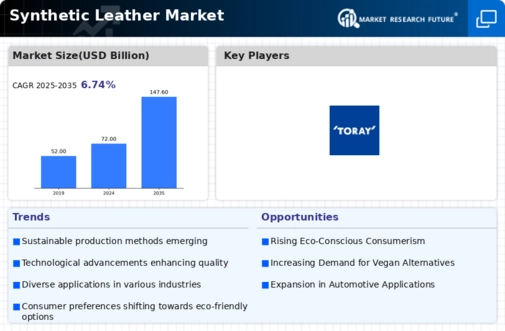Automotive Sector Growth
The automotive sector's expansion is significantly influencing the Synthetic Leather Market. As vehicle manufacturers increasingly prioritize interior aesthetics and comfort, synthetic leather is being utilized for upholstery, dashboards, and other interior components. This material offers a cost-effective and versatile alternative to traditional leather, appealing to both manufacturers and consumers. Market forecasts suggest that the demand for synthetic leather in the automotive industry will continue to grow, driven by trends towards lightweight materials and enhanced durability. As automakers seek to improve vehicle interiors while adhering to sustainability goals, the Synthetic Leather Market is likely to benefit from this upward trajectory.
Technological Innovations
Technological advancements are transforming the Synthetic Leather Market, enabling the development of high-quality, durable, and versatile synthetic materials. Innovations in production techniques, such as 3D printing and advanced coating technologies, are enhancing the aesthetic and functional properties of synthetic leather. These advancements allow for greater customization and improved performance, appealing to a broader range of applications, from fashion to automotive. Market data suggests that the integration of smart technologies, such as temperature regulation and moisture control, is also gaining traction. As manufacturers continue to invest in research and development, the Synthetic Leather Market is poised for growth, driven by the demand for innovative and high-performance materials.
Sustainability Initiatives
The increasing emphasis on sustainability appears to be a pivotal driver for the Synthetic Leather Market. As consumers become more environmentally conscious, the demand for eco-friendly alternatives to traditional leather is rising. Synthetic leather, often produced from recycled materials, offers a sustainable option that aligns with these consumer preferences. Reports indicate that the market for sustainable materials is projected to grow significantly, with synthetic leather expected to capture a substantial share. This shift not only reflects changing consumer attitudes but also encourages manufacturers to innovate and adopt greener production processes. Consequently, the Synthetic Leather Market is likely to witness a surge in demand as brands strive to meet sustainability goals and cater to eco-aware consumers.
Rising Demand in Fashion Industry
The fashion industry is increasingly adopting synthetic leather, which serves as a key driver for the Synthetic Leather Market. With a growing number of designers and brands opting for cruelty-free and sustainable materials, synthetic leather is becoming a preferred choice. This trend is particularly evident in the production of handbags, footwear, and apparel, where aesthetics and ethical considerations intersect. Market analysis indicates that the demand for synthetic leather in fashion is expected to rise, as consumers seek stylish yet sustainable options. This shift not only reflects changing consumer preferences but also encourages brands to explore new design possibilities, further propelling the growth of the Synthetic Leather Market.
Consumer Awareness and Preferences
Consumer awareness regarding animal welfare and environmental issues is shaping preferences in the Synthetic Leather Market. As more individuals become informed about the ethical implications of traditional leather production, there is a noticeable shift towards synthetic alternatives. This trend is particularly pronounced among younger consumers, who are more likely to prioritize sustainability and ethical sourcing in their purchasing decisions. Market data indicates that brands that align with these values are experiencing increased loyalty and sales. Consequently, the Synthetic Leather Market is adapting to these changing consumer preferences, leading to a rise in innovative products that cater to the demand for ethical and sustainable materials.

















Leave a Comment